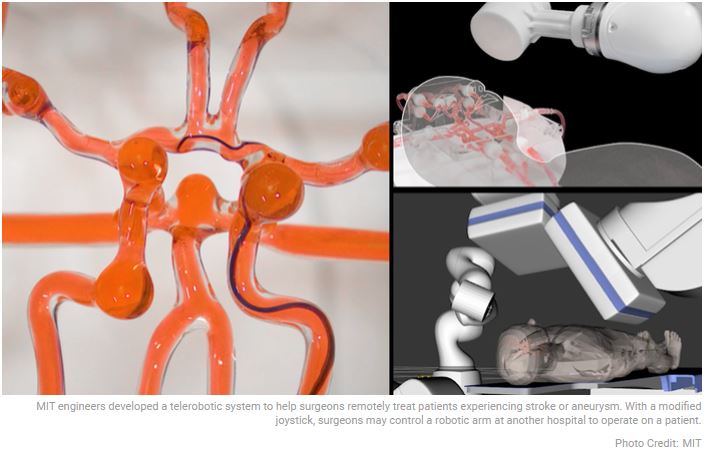 Endovascular intervention is an emergency medical procedure to treat strokes caused by a blood clot. Normally this procedure requires a surgeon to manually guide a thin wire to the clot to physically clear the blockage or deliver drugs to break it up. MIT engineers are working to find a solution to treat strokes remotely when needed.
Endovascular intervention is an emergency medical procedure to treat strokes caused by a blood clot. Normally this procedure requires a surgeon to manually guide a thin wire to the clot to physically clear the blockage or deliver drugs to break it up. MIT engineers are working to find a solution to treat strokes remotely when needed.
Engineers at MIT have “developed a telerobotic system to help surgeons quickly and remotely treat patients experiencing a stroke or aneurysm. With a modified joystick, surgeons in one hospital may control a robotic arm at another location to safely operate on a patient during a critical window of time that could save the patient’s life and preserve their brain function.”
Many people living in rural areas, find accessibility to advanced medical care an ongoing issue. Neurovascular surgeons are typically based out of major medical facilities, making it difficult for people living in remote areas to reach them, especially during a critical moment like the initial onset of a stroke. This technology could open the door to other medical innovations to enable people living in rural areas to get the medical interventions they need during the critical time they need them.
The MIT team envisions that its robotic system would be installed in smaller hospitals “and remotely guided by trained surgeons at larger medical centers. The system includes a medical-grade robotic arm with a magnet attached to its wrist.” This will shorten the time drastically of transporting a patient from a remote area to a major medical institution when time is of the essence.
Robotics in the medical field isn’t new, but there are some procedures in which a robot may not be an ample replacement for a human. A surgeon can twist or maneuver an instrument during some procedures, with a kind of sophistication that has yet to be replicated by a robot. This procedure, however, is one that works in conjunction with a surgeon, enabling them to steer a guidewire through vessels, and around narrow pathways to reach its destination, so there is continued hope that this system will be further developed and then put to use across the country.